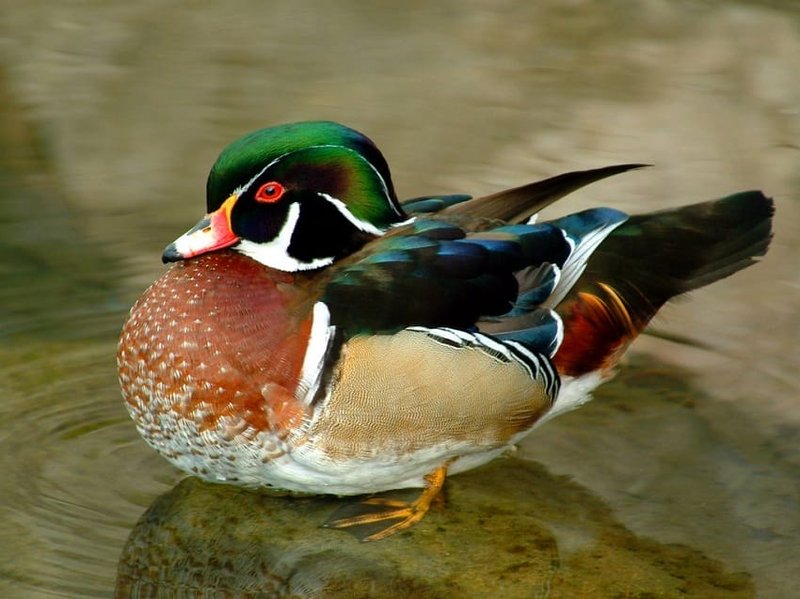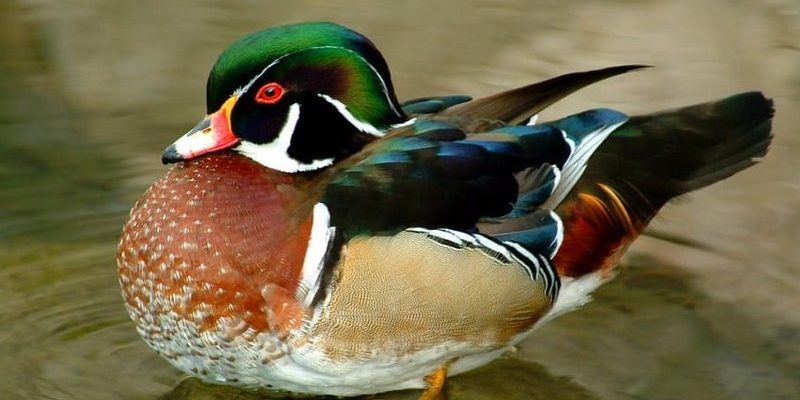
Let me explain. Wood ducks are unique, not just in their appearance but also in their preferences for living spaces. They tend to favor wooded swamps and marshes, often hiding among the trees along rivers and streams. Imagine walking through a serene forest, maybe hearing a soft quack echo through the trees; that’s where you might just find a wood duck! So, let’s dive into the different places across the globe where you can catch a glimpse of these captivating waterfowl.
North America: The Heart of the Wood Duck’s Range
The wood duck is primarily found throughout North America, making it one of the most familiar species in the United States. They are widespread in the eastern and western parts of the continent, especially in areas with abundant water sources and tree cover.
In the eastern states, you’ll commonly see wood ducks in places like the Everglades, the Great Lakes, and the Mississippi River basin. They prefer shallow waters with plenty of vegetation for cover. You might spot them perched on low branches or gliding gracefully over the water. Their nesting sites are often tree cavities, so keeping an eye on the forested areas near water can reward you with a sighting.
Interestingly, in the western states such as California and the Pacific Northwest, wood ducks can also be found. Here, they enjoy the lush landscapes, often choosing areas like the Sacramento Valley or the Columbia River for their habitats. The mix of wetlands and wooded areas provides the perfect environment for these stunning birds.
Woodland Swamps and Wetlands
Wood ducks thrive in woodland swamps and marshes, as these habitats provide the food and shelter they need. They mostly feed on seeds, fruits, and aquatic plants, which are abundant in these environments. Take a stroll through a swamp, and you might just see them diving for a snack!
Furthermore, these wetlands are crucial for the wood ducks’ breeding. They choose secluded areas for nesting, often high in tree cavities, away from predators. If you’re in swampy areas during spring and summer, keep your eyes peeled; you might spot a mama wood duck leading her ducklings through the water!
Central America: A Stopover for Wood Ducks
Though predominantly North American, the wood duck doesn’t shy away from migration. Central America serves as a stopover on their journey south. For instance, during the winter months, you might find them in the southern parts of Mexico and Guatemala. They tend to inhabit similar swampy and wooded areas, basking in the warmer climate.
As they migrate, wood ducks seek out habitats that mimic their northern homes. Here, they rely on various wetlands and riparian zones, maintaining their preference for secluded environments. If you happen to be in Central America during the winter, you could get lucky and spot some of these ducks making a pit stop!
Roles in Ecosystem
Wood ducks play an important role in their habitats. They help in seed dispersal, contributing to the health of their ecosystems. By feeding on various seeds and fruits, they help promote plant growth, which is essential for other wildlife in the area. So, spotting a wood duck isn’t just a delightful experience—it’s also a chance to appreciate their contribution to nature!
Wood Ducks in the Caribbean Islands
Believe it or not, wood ducks have also been spotted in the Caribbean islands! Islands like Cuba and the Bahamas offer lush environments similar to their preferred habitats. These areas boast mangroves, wetlands, and forested regions that appeal to wood ducks.
In Cuba, particularly, wood ducks can be witnessed in areas like Zapatas Swamp, where they find plenty of food and nesting options. If you’re visiting the Caribbean, keep your camera ready because you might just catch sight of one of these vibrant ducks flying low over the water or perched in the trees!
Local Conservation Efforts
In these regions, local conservation efforts are crucial for maintaining healthy habitats for wood ducks. Organizations work tirelessly to protect these areas from pollution and development, ensuring that the wood ducks have a place to thrive. If you’re interested in birdwatching, participating in local conservation initiatives can be a rewarding way to contribute!
Europe: An Unexpected Visitor
Surprisingly, wood ducks have also found their way to Europe, albeit as a non-native species. They have been spotted in parts of Great Britain and Sweden, where they have been introduced for ornamental purposes. Though not as common as in North America, seeing a wood duck in Europe is still a possibility, especially in parks and gardens with ponds.
The habitats in Europe are not entirely different from those they prefer in America. Parks with lush greenery and water sources can attract wood ducks, giving birdwatchers a unique opportunity to spot these beautiful birds across the pond.
Naturalized Habitats in Europe
In these European locations, wood ducks often find themselves in park settings or near large bodies of water with plenty of covering vegetation. They look for nesting sites in tree cavities or even in floating nests if the conditions allow. If you’re birdwatching in these areas, keep an eye out near the water’s edge, especially during the early morning or late afternoon when they are most active.
Understanding Wood Duck Behavior
To truly appreciate wood ducks, it’s helpful to understand their behavior. They are known for being shy and elusive, often hiding among the reeds and branches. Their bright colors, however, make them stand out when they take flight.
Wood ducks are incredibly agile fliers. They often fly straight and low above the water, which is not just beautiful but also a clever way to avoid predators. You might see them quickly darting into the trees or diving underwater to evade danger.
Breeding and Nesting Habits
Breeding season for wood ducks usually occurs in late winter or early spring. Males are known for their vibrant colors, which they display to attract females. Once a pair forms, they will scout for suitable nesting sites. The female will lay anywhere from 6 to 15 eggs, and she alone takes on the responsibility of incubating them.
After about 30 days, the ducklings hatch. Here’s a fun fact: the ducklings are precocial, meaning they can swim and feed themselves almost immediately after hatching. Following their mother to the water is always an enchanting sight!
Conservation of Wood Duck Habitats
While wood ducks have adapted well to various habitats, their populations face challenges from habitat loss and pollution. Wetland destruction and urban development have made it harder for them to find the necessary environments to thrive.
Conservation efforts are crucial in maintaining healthy populations of wood ducks. Organizations work to protect and restore wetland areas, ensuring these ducks have safe places to live, feed, and breed. Getting involved in local conservation groups can make a significant impact—every little bit helps!
Tips for Birdwatchers
If you’re eager to spot wood ducks, here are a few tips:
- Visit wetland areas during the early morning or late afternoon when ducks are most active.
- Bring binoculars for a closer look without disturbing them.
- Be patient and quietly observe—shy birds will often reveal themselves with a little time.
Wrapping Up on Wood Duck Adventures
So, there you have it! The wood duck’s habitats span across North America, Central America, the Caribbean, and even parts of Europe. These ducks offer a blend of beauty and mystery, making them a favorite among bird watchers and nature enthusiasts.
Whether you’re wandering through a local park, a lush swamp, or even a garden pond, keep an eye out for these striking birds. Their presence not only adds a splash of color to our world but also reminds us of the importance of conserving our natural habitats. Happy wood duck spotting!

